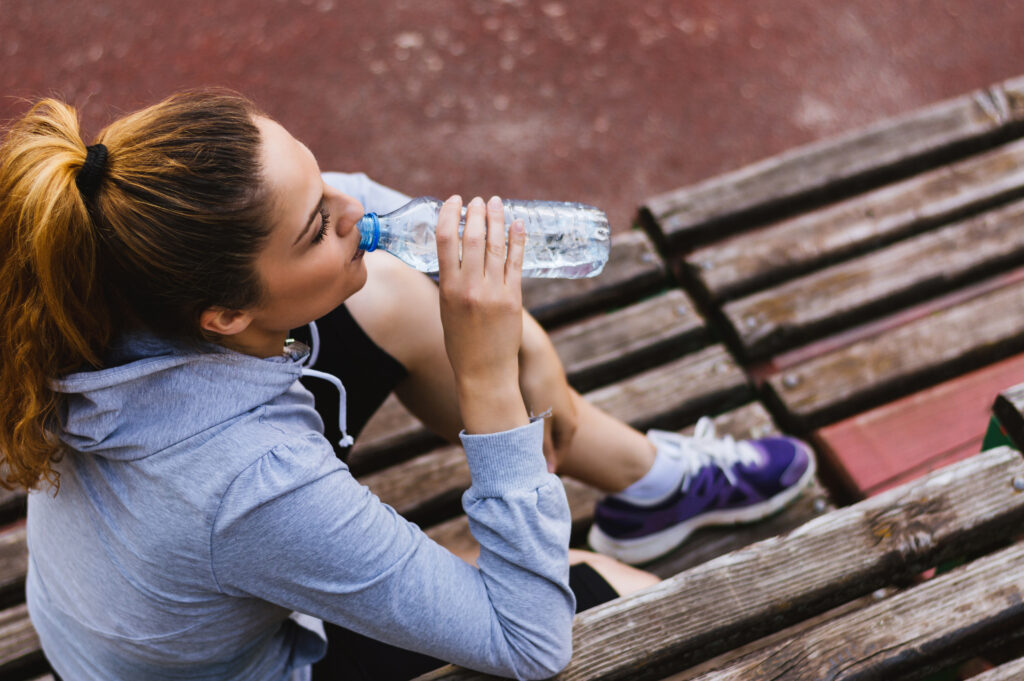The Hidden Dangers of Microplastics in Water
You read about them in the news, see warnings on social media — microplastics are all around us, from drinking water to clothes, cookware and personal care items. The result?
Scientists are finding increasingly high levels of microplastics, equivalent to the amount in a plastic spoon, accumulating in the body’s vital organs, including deep inside the brain. Recent studies suggest a link between microplastics and elevated risks of heart attack, chronic diseases, cell damage and a host of other issues.

Research is ongoing into the full effects of microplastics on human health and the environment. However, the rate of bioaccumulation is increasing, by as much as 50% over the last eight years, according to the University of New Mexico Health Sciences.
Bottled water as well as tap water are notorious sources of microplastics, and getting cleaner water is an important step toward reducing your overall exposure and protecting your health. In this article, we’ll examine the impacts of microplastics in water, common sources of pollution and associated health risks.
What Are Microplastics?
Microplastics are tiny, often microscopic plastic particles, less than 5 millimeters in size, or less than the width of a paperclip. Nanoplastics are even smaller at less than 1 micrometer (µm), capable of breaching cell membranes and accumulating in living tissue. A piece of human hair, by comparison, is approximately 70 micrometers thick.
Nano/microplastics (NMPs) aren’t biodegradable and break down into smaller and smaller pieces over time, persisting in ecosystems and water resources for centuries. There are two primary classifications of microplastics:
- Primary microplastics: Intentionally manufactured for use in consumer products, such as microbeads in facial cleansers or industrial abrasives.
- Secondary microplastics: Broken down particles of plastic from larger plastic materials, such as tires, synthetic clothing fibers and plastic packaging.
Common Sources of Microplastics in Water
Tap water and bottled water are two of the most common sources of microplastics when it comes to water. Drinking, cooking, washing dishes or bathing — all of these uses of water expose people to thousands of tiny micro- and nanoplastics each year. Plus, if you drink out of plastic cups and water bottles, microplastic particles and other chemicals can leach into the water.
Bottled water is one of the worst offenders, containing an average of 240,000 tiny plastic particles per liter, the majority of which are nanoplastics, according to a 2024 study by Columbia and Rutgers University.
Microplastic levels vary by municipality, but have been found in 94% of US tap water samples, with an average of 4-6 particles per liter. While that number seems low, testing requires highly specialized equipment and doesn’t routinely account for nanoplastics, making total NMPs in tap water likely much higher. Microplastics are generally lower in well water, though data and detection methods are also limited.

How Microplastics Get Into Our Water Supply
Your tap water is part of a vast and regenerative cycle, flowing from rivers and reservoirs to treatment plants, collecting microplastics along the way from industrial runoff, landfill leaching, groundwater contamination and everyday human water use.
Due to the limitations of wastewater treatment, many nano- and microplastics bypass filtration and are discharged back into waterways and the environment. Plastics in landfills break down into microscopic pieces, polluting surface and groundwater which make their way into municipal systems and, eventually, your tap water.
Municipal water treatment plants can remove up to 90 to 99% of microplastics from tap water using microfiltration. However, current systems aren’t equipped to remove nanoplastics.
As for bottled water, NMP levels are significantly higher than tap water, as microplastics shed from the bottle and cap into the water during production, transportation and storage. Exposure to heat drastically increases microplastic release from plastic into water, meaning you should think twice before leaving water bottles in the hot summer car.
Health Risks Associated With Microplastics
Due to the minimal to nonexistent biodegradation of microplastics, their environmental pollution is widespread and consistently impacts humans, ecosystems and wildlife. Ingestion and accumulation of NMPs in the human body have been linked to a variety of serious health conditions, depending on factors such as exposure level and time, plastic particle type and your general physiological state.
Health risks of nano- and microplastics may include:
- Endocrine, reproductive and kidney dysfunction
- Disruption of brain development, potentially impairing learning and memory
- Chronic inflammation and oxidative stress linked to heart attack, stroke and other cardiovascular issues
- Inflammatory bowel disease
- Potential increased risk of cancer and neurodegenerative diseases, including dementia
Microplastics pose a threat to your health and the environment in part because they act like a magnet to adsorb harmful pollutants such as PCBs and heavy metals.
Ongoing research indicates that microplastics contain toxic additives from the manufacturing process, including flame retardants and plasticizers like phthalates and BPA. These substances can leach out after ingestion of microplastics, getting into your bloodstream, digestion and vital organs.
There are currently no clear federal guidelines or regulations on safe nano/microplastic exposure levels.

How to Reduce Microplastics at Home
A few ways you can limit your exposure to microplastics at home include:
- Using water treatment such as reverse osmosis purification
- Drinking out of glass or ceramic versus plastic cups
- Choosing natural-fiber clothes and textiles over synthetics
- Eliminating single-use plastics (from water bottles to food storage containers and plastic tooth brushes)
- Modifying diet: seafood, instant rice, sea salt, sugar and many ultra-processed foods contain elevated amounts of microplastic
There are three primary routes of NMP exposure to consider as you seek to lead a healthier, more microplastic free lifestyle: inhalation, digestion and absorption through skin (via clothes, cosmetics, etc.).
If you own polyester bedding, for example, a single cycle in the washer can release up to 700,000 microplastic fibers (MPFs) into your home’s wastewater. Municipal treatment plants struggle to remove MPFs, especially nanoplastics, leading to pollution of rivers and waterways part of the drinking water cycle.
Below, we’ll look at a few ways to reduce nano- and microplastic in the water you drink and use every day.
Choose Water Filters That Target Microplastics
Not all water filters and treatment systems are created equal, nor can they all target microplastics for removal. And since municipal water treatment plants aren’t designed to remove nanoplastics, this leaves the burden on individuals.
The most effective way to eliminate nano- and microplastics from water is to use reverse osmosis purification. In some cases, advanced multi-stage filtration can be effective, capable of filtering down to 0.01 or 0.02 micrometers (µm), depending on the manufacturer. For reference, nanoplastics are 1 µm or smaller.
Reverse osmosis systems, such as the Kinetico K5 Drinking Water Station®, push water through a semi-permeable membrane, effectively removing up to 98% of contaminants, including PFAS, VOCs, metals, phthalates and microplastics down to 0.0001 µm.

Reduce Plastic Use at the Source
Cut back on the products you use at home that could be putting microplastics into your water. For example, opt for glass, steel and ceramic cups, kettles and storage containers over plastic. Eliminating plastic water bottles is also a major step and can reduce your ingestion of microplastics (not nanoplastics) by nearly 90,000 plastic particles per year.
Boil Tap Water
Boiling tap water for five minutes can achieve up to 80-90% reduction of NMPs in a pinch, though must be poured through an unbleached coffee filter.
This relies on you having hard water because the microplastics co-precipitate with calcium carbonate, that is, they bind to the calcium and stay behind in the mineral deposits. Look to water purification or ultrafiltration for a more sustainable, long-term solution.
Are All Water Filters Effective Against Microplastics?
Explore the chart below to compare common water treatment options on the market and how they handle microplastics. For best results, consult with a water quality expert to learn what’s your water and how best to remove impurities.
| Filter Type | Effectiveness Against Microplastics | Notes |
|---|---|---|
| Carbon Filters | ⚠️ Limited | Not designed to remove microplastics or any particulate matter, sediment or chemicals under 5 microns. |
| Reverse Osmosis (RO) | ✅ Highly Effective | Uses a semipermeable membrane to eliminate most microplastics. |
| Ultrafiltration (UF) | ✅ Effective | Can target particles down to 0.02 microns, which includes many microplastics. |
| Mechanical Filtration (e.g., sediment) | ⚠️ Limited | Only captures larger particles down to 5 microns; most NMPs are too small. |
| Distillation | ✅ Effective | Boils water and condenses vapor to eliminate contaminants including micro- and nanoplastics. Less common for homes due to extremely slow use. |
| Ion Exchange | ❌ Not Effective | Not designed to remove solid particles such as microplastics. |
| Pitcher & Fridge Filters | ⚠️ Limited; varies by brand/model | Some may reduce microplastics, but most aren’t rated for this use. |
Choose Kinetico for Cleaner, Safer Water
At Kinetico, we’ll help you find the right type of water treatment for your home or business. Our certified water quality experts start with a scientific water analysis to determine the exact contaminants in the water, from chlorine and forever chemicals to microplastics, to identify the best possible solution for healthier, cleaner water without compromise. Schedule your free water test today to get started.
